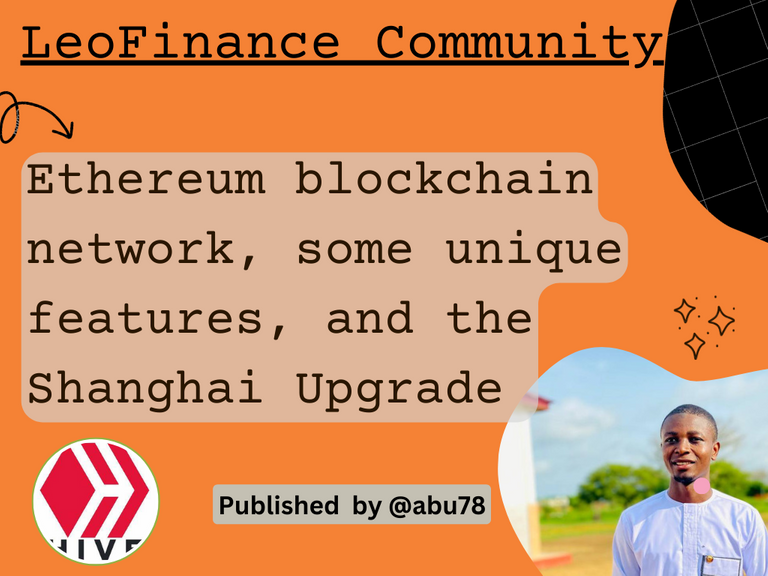Ethereum Blockchain Network and some unique features of it
Greetings to all and sundry on this platform, I am very excited to write and share with you all another interesting topic today as an entry to the Finance Bro adventure Quest of the Leofinance Zealy Campaign. I would be tackling Ethereum today as my topic and I hope that you guys would enjoy reading this article. Basically, we would be looking at what Bitcoin is all about, the history behind it, the Founders of Ethereum, the uniqueness of the Ethereum blockchain network, understanding of Ethereum Name Service (ENS), the London hard fork of Ethereum, and also the Shanghai Upgrade. Stay tuned with me as I explore this topic with you guys. Without much ado, I would like to set the ball rolling. So we would be looking at what Bitcoin is in the first place and probably look at the others after this.

What is Ethereum
If asked this question would you just say that it is a cryptocurrency and that is just all, NO. You need to dive deeper into the subject and that is what I would be doing in this article. Ethereum network is a decentralized blockchain network that operates as an open-source blockchain and has its own cryptocurrency that is ETH (Ether) running on the network. With it having its own currency on the blockchain network, it also hosts other cryptocurrencies as well. The Ethereum blockchain network is also responsible for executing decentralized smart contract networks on its platform. The Founder of Ethereum known as Vitalik Buterin described Ethereum in its whitepaper in 2013. To start with the project, they first launched an online public crowd sale which they used to gather funds for the project. This fundraising was done somewhere in the summer of 2014. After the sale was over, they were able to raise an amount of $18.3 million BTC with over 60 million Ether sold as of then. The price of Ethereum in the Initial Coin Offering (ICO) was known to be at $0.311 after those sales were made.

Officially, the Ethereum blockchain was launched by the foundation on the 30th of July 2015 and was under the prototype code called “Frontier”. Since its launch, a lot of updates have been done to date. We can recall the “Constantinople” update done on the 28th of February 2019, the “Instanbul” update done on the 8th of December 2019, the “Muir Glacier” update done on the 2nd of January 2020, the Berlin update on the 14th of April 2021, and lastly the current update done in “London” on the 5th of August, 2021.
The main goal or aim of the Ethereum blockchain is to create or develop a platform where decentralized applications can be run and also to permit users across the globe to run software that is immune to fraud, censorship, and downtime.
Founders of Ethereum
Generally, a total of eight co-founders are known for the Ethereum blockchain network and that is one of the projects with a large number of founders for a single project. A meeting scheduled in Zug, Switzerland was the first meeting of these eight co-founders and it occurred somewhere in 2014. The most popular or known co-founder is Vitalik Buterin, a Russian-Canadian. He was the first person to describe Ethereum in the original whitepaper of Ethereum. They have been working since then to help improve the platform and also bring in more developments since when it was launched. This co-founder of Ethereum, Buterin before he founded Ethereum was also the co-founder of the Bitcoin Magazine news website and he was the one that wrote that as well.
The next co-founder among those eight co-founders who was also a key to Ethereum Foundation was Gavin Wood. He was a British programmer and he was the first to encode the technical implementation of Ethereum in C++ programming language. He was also the first chief technology officer for the Ethereum blockchain Foundation and he was the one that proposed the fort Ethereum’s native programming language. He was working as a research scientist at Microsoft before Ethereum and after which he then decided to move on to help in the development and establishment of the web3 platform.
Other co-founders that play important roles in its development include; Anthony Di Lorio who during the early stages of Ethereum development unwrote the project. Also, the Swiss-based Ethereum Foundation and its legal framework were established and developed by Charles Hoskinson. There is one co-founder who helped a bit but later stepped away and that was Amir Chetrit. Assistance was also provided by Mihai Alisie to help in the establishment of the Ethereum blockchain network. Finally, another Canadian Entrepreneur called Joseph Lubin also aided in the early development and establishment stages of the Ethereum platform and he also founded an incubator that was used as a start-up.

What makes Ethereum Unique
Ethereum blockchain was the first blockchain network or was among the first blockchain a network that pioneered the concept of smart contract blockchain platforms. The Ethereum blockchain platform was created to reduce transaction fees and also serve as an intermediate between trusted contractors. According to Gavin Wood, he said Ethereum's main aim was to serve as "one computer for the entire globe". This basically gives the insight or the vision of the Ethereum blockchain network.
Ethereum blockchain network, aside from the smart contracts that they execute on their platform, was also created or designed to be a host of cryptocurrencies that is tokens, on their blockchain network. The Ethereum blockchain platform is able to host these tokens by using the ERC-20 compatibility standard that they possess. Over 280,000 ERC-20-compliant tokens have been launched so far and out of that, over 40 tokens are seen in the top 100 cryptocurrencies by market capitalization. Examples include BNB, LINK, USDT, and others.
What is Ethereum Name Service
Ethereum Name Service (ENS) is a naming system based on the Ethereum blockchain network that is extensible and distributed. It serves as the web3 version of the domain name service (DNS). Ethereum Name Service provides solutions to the loss of funds and also the difficulties in reading cryptocurrency addresses. As we all know how cryptocurrency address looks so lengthy and also mixed up with letters and numbers, it would definitely make it difficult for people to read.
It can lead to loss of funds in situations where the user makes a mistake when inputting the crypto address and then transfers the assets. What ENS does is that they assign human-readable names to machine-readable identities which include metadata, content hashes, Ethereum addresses, and other crypto addresses. ENS also helps to shorten the long crypto address format to a simple and short form where assets can easily be saved and stored, like "Abu.eth". ENS functions based on two smart contracts of Ethereum and they are the ENS registry and the Resolver. The ENS registry records three important pieces of information that are; owner of the domain, resolver for the domain, and caching time for records under the domain. The latter which is the Resolver, functions by translating the machine-readable address to the domain name and vice-versa.
The London Hard Fork of Ethereum
The transaction fees of Ethereum have peaked at high transaction fees and to me, that seems, to be the network with the most transaction fees I have seen so far. Interestingly, it even spikes when there is high demand in the market. Somewhere in May of 2021, the average transaction for Ethereum peaked at $71.72, hmmm which is almost $100 for performing a transaction on the platform. There are also a few issues with scalability on the Ethereum blockchain and as such they have planned and worked on moving the network to a proof-of-stake (PoS) consensus algorithm.
Ethereum Shanghai Upgrade
After Ethereum merged with the Proof-of-Stake consensus algorithm, another big upgrade for Ethereum occurred recently and that is what is termed the Ethereum Shanghai upgrade. This upgrade allows users to unstake their staked ETH and be withdrawn from the Beacon Chain. During the time of the merge, Ethereum's proof-of-work chain as well merged with that of proof-of-stake Beacon Chain. With this merge, validators can only stake 32 ETH in order to keep the network secured and safe. This 32 ETH staked can never be unstaked and that led to this recent upgrade.
Withdrawals from the Zhejiang testnet were enabled on the 7th of February 2023, after which the upgrade was successfully launched on the 28 February of the same year. The hard fork was executed on the 23rd of March 2023 on Goerli testenet.
This is where I would bring my article to an end for today, and I would like to thank everyone that read and followed my article this far. Also, I would like to say a very big thank you to the leaders and MODs of the Leofinance community for such wonderful artwork they keep on doing. Kudus to the team.

Posted Using LeoFinance Alpha
Congratulations @abu78! You have completed the following achievement on the Hive blockchain And have been rewarded with New badge(s)
You can view your badges on your board and compare yourself to others in the Ranking
If you no longer want to receive notifications, reply to this comment with the word
STOPCheck out our last posts: